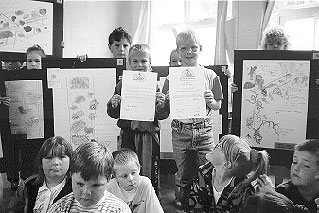

It all started when the children at ‘my’ school (Dowson First School, where my partner, Anne Casey teaches) noticed that the school’s old roofs were covered in moss and lichens, but the new ones weren’t. 
So, using some microscopes I brought in, (but working at ground level!), we looked at these strange ‘plants’ more closely. We talked about their sensitivity to their environment and why they grow so very slowly. They learned a number of new words and lots about atmospheric pollution ? not bad for seven year olds! In fact, I was amazed with the way they happily took on board quite complex ideas, e.g. the long time it takes for the alga to form, for the fungal partnership to become established, and the eventual colonisation of lichens to take place.
The children seemed so interested that we decided to enter the children in an environmental competition for schools and settled down to plan how it could be done. The teachers knew what the children would be able to cope with and succeed at, and I knew what science it would entail. Our theme was ‘Using Lichens as Pollution Monitors’.
Back at work I put together a set of ‘research kits’ for the children: each one had a plastic folder, pen, paper, ruler, plastic Petri dish and a plastic 15ml tube. The children took these home to collect samples of rainwater and to measure the lichens in their locality. At school, we tested the acidity of their rainwater samples using indicator solution and noted their observations of lichens.
After recording their work over several weeks, they presented their results on a large map and wall posters. They also gave a special assembly for their parents to explain what they had done and to show why there was no lichen on the new school roofs.
We didn’t expect to win the competition; it was really for 8-18 year olds, but the children were complimented on their work and they were thrilled to be awarded a certificate signed by David Bellamy.